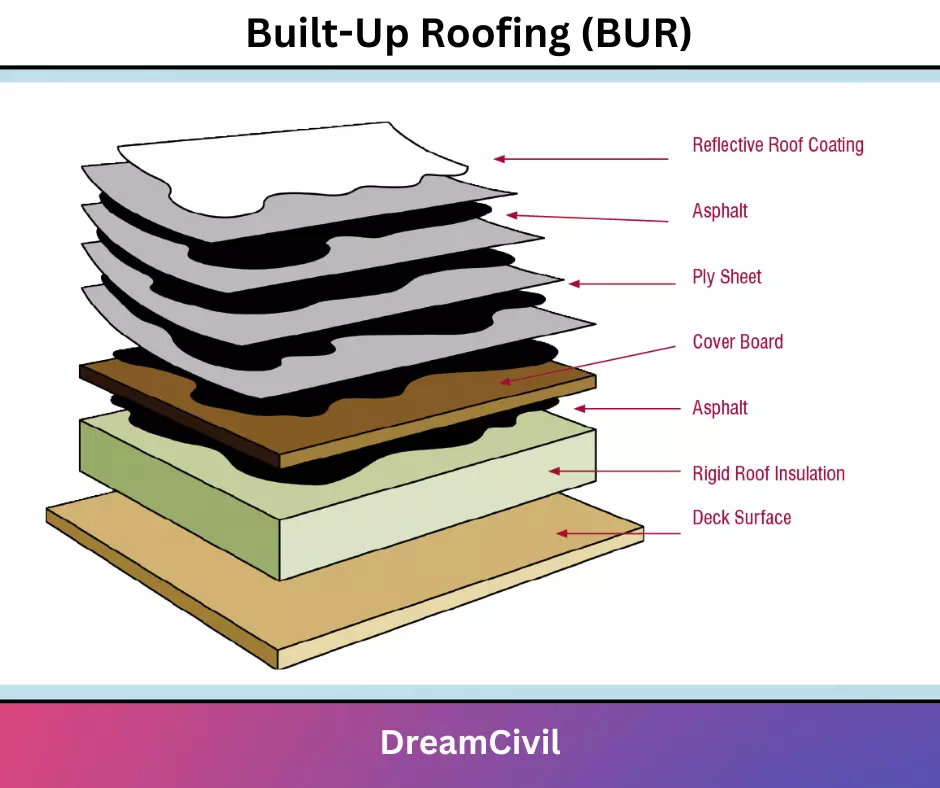Table of Contents
Bitumen is a solid or semisolid, black, sticky, ductile substance, obtained as an important byproduct from the distillation of crude petroleum.
Bitumen implies a group of hydrocarbons often mixed with some organic matter. It is known as petroleum in the fluid state, mineral tar in the semifluid state, and asphalt in the solid state.
| Summary There are mainly two sorts of bituminous roofing systems that are built-up roofing (BUR) and multi-ply, polymer-modified bitumen. ModBit System possesses a cap sheet and base plies, which share similar reliable waterproofing advantages with BUR Systems. In addition, roofing contractors can change Modbit Systems extensively, ensuring it meets their specific requirements. Roofing manufacturers surface the cap sheets within the ModBit Systems with a mineral granule to expand the system’s weather ability. They employ cool roof coatings and granules to reflect UV rays, significantly raising the roof’s long-time performance and decreasing the building’s energy costs. If you want to put more properties like fire safety on the roof, consider installing smoke vents. |
1. What is Built-Up Roofing (BUR)?
BUR Systems is used by many contractors in the USA for decades because of its general reliability and efficiency in covering a building’s interior. The system has alternating bitumen-coated membranes, and oxidized bitumen known as felt or ply sheets.
You can support the ply sheets with a firmly stable, high-tensile strength fiberglass mat. Roofing manufacturers also surface the system with a roof coating or aggregate to improve the weatherproofing capability.
The multi-ply system ensures the system has reliable waterproofing, which is why the roofing can survive for many years.

a. What are SBS Membranes?
While the major two types of bituminous roofing systems are BUR and ModBit Systems, you will catch that the current market has two primary polymer-modified bitumen membranes, particularly the APP and SBS Membranes.
The first type currently recognized in the market is SBS membranes, made with bitumen that manufacturers changed utilizing Styrene-Butadiene-Styrene (SBS) polymers. It includes an asphalt coating that has a rubbery texture.
Roofing contractors apply the coating to a reinforcing carrier of fiberglass for dimensional stability and high tensile strength. You will also find polyester to achieve superior elongation and tear strength or a compound of the two.
If you want to learn the benefits, SBS membranes can provide great flexibility, especially during cold seasons. It is also self-adhering, but roofing contractors usually install it with cold adhesive or mopping asphalt.

b. What are APP Membranes?
The polymer-modified bitumen membrane contains bitumen modified with plastic Atactic Polypropylene (APP) polymers, which provide a coating with a high-temperature range, better durability, and toughness.
You can commonly use the coating to a polyester carrier mat, but a small number of fiberglass products also exist. Most contractors torch-apply APP membranes because it softens fast because of the plasticized bitumen.

2. Modified Bituminous Roofing
This modified bituminous roofing system is made of a cap sheet and base piles which help to control water penetration. The cap sheet surfaces are modified with mineral granules to extend their weather ability. It is also known as the Modbit system.
This system employs granules and cool roof coatings to reflect the UV rays, which assists in improving the durability of the roof and decreasing building energy costs.
Advantages of Modified Bitumen Roofing Systems
The advantages of Modified Bitumen Roofing systems are as follows:
a. Ensuring Quality.
b. Making Installation a Breeze.
c. Preventing Water Intrusion.
d. Holding Up Against Strong Winds.
e. Remaining Structurally Sound at Low Temperatures.
f. Reducing Construction Waste.
a. Absorbs heat in summer.
b. The most common application methods are still higher risk than single-ply systems.
c. Mod bit can be more costly.
d. More weak to ponding than thermoplastics.
3. Benefits of Using Bituminous Roofing Systems
Some benefits of using bituminous roofing systems are as follows,
1. High Resistance to Physical Damage
2. Low-Maintenance Roof
3. Easy to Install
4. Energy-Efficient
| Read Also: Difference Between Bitumen and Tar |

